 By Cate York
By Cate York
CUB Sustainable Communities Liaison
Hello! My name is Cate, and I’m part of CUB’s outreach team. I spend a lot of my time talking with people about how to save money on their bills. That and googling Instant Pot recipes while binging murder podcasts. A few months ago, I stepped away from a Tuscan white bean soup to sign up for a community solar subscription. Here’s what I learned.
1. What is community solar?
Let’s back up for a minute. Community solar allows residents and organizations to benefit from solar energy without installing panels on their properties. You can subscribe to a share of a community solar project somewhere in your utility service territory, and in return, receive credits on your electric bill. As a renter, that sounded pretty good to me. (Tip: CUB has a great resource on community solar: SolarInTheCommunity.com.)
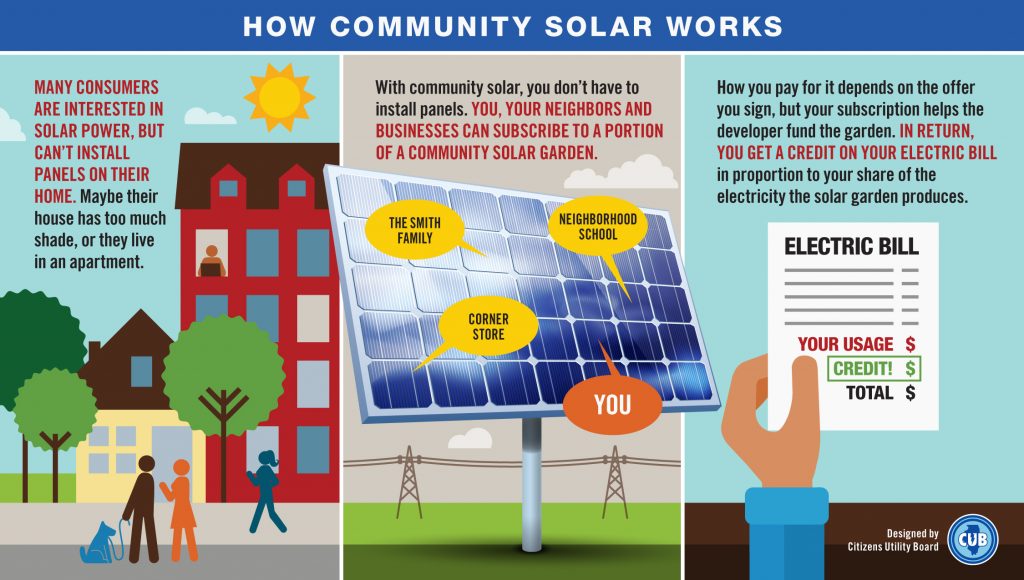
Illinois has been experiencing a solar boom because of state legislation from a few years ago called the Future Energy Jobs Act, or FEJA. FEJA created incentives for new wind and solar built in-state, so we now have two solar programs: Illinois Solar for All and Illinois Shines.

- Illinois Solar for All is a state-administered solar incentive program to support solar in low-income communities. There aren’t any upfront costs, and savings are guaranteed (participants only pay for half of the value of the bill credits they receive). For the community solar portion of the program, qualification is based on household income.
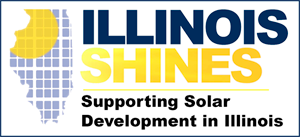 Illinois Shines is a state-administered solar incentive program to support solar across the state, regardless of income. Unlike Illinois Solar for All, Illinois Shines’ community solar program allows upfront costs, and savings are not required, though many of the offers we’ve seen so far do guarantee savings.
Illinois Shines is a state-administered solar incentive program to support solar across the state, regardless of income. Unlike Illinois Solar for All, Illinois Shines’ community solar program allows upfront costs, and savings are not required, though many of the offers we’ve seen so far do guarantee savings.
Both Illinois Solar for All and Illinois Shines also have rooftop solar sub-programs, so solar is more affordable than ever for homeowners. If I won enough online Texas hold ‘em games to somehow acquire a house, I would strongly consider buying panels within the next year, because there are federal and state incentives that are expiring. These incentives go to the solar system owner, so that’s one reason to explore financing through a solar loan, instead of a lease or Power Purchase Agreement.

If you are thinking about signing up for community solar, consider it sooner than later. There is limited space available in these programs, and not enough funding to meet demand. (Check out CUB’s guide to the Clean Energy Jobs Act, proposed state legislation that would boost solar funding.)
2. Which projects are available to me?
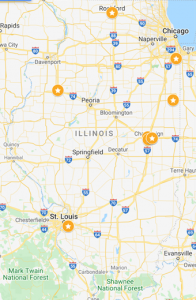
The 9 community solar projects that have received funding so far (as of July 2020) through Illinois Solar for All.
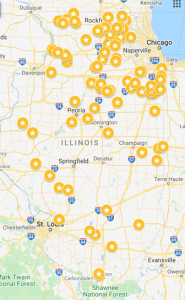
The 112 community solar projects that received funding through Illinois Shines.
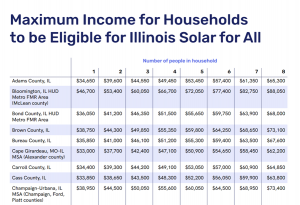
The income requirements for Illinois Solar for All depend on where you live. (Click the image to see details.)
So far, as of July 2020, there have been 9 Illinois Solar for All community solar projects funded: 7 in Ameren Illinois territory, and 2 in ComEd territory. More projects will be funded over the next several years. I checked the income eligibility requirements for my county on the Illinois Solar for All website, and I don’t qualify, so that made the decision to sign up for Illinois Shines easy. (If I did qualify, I would choose Illinois Solar for All, because I would likely save more on that program.)
The community solar projects within the Illinois Shines program were approved for funding in a February 2019 lottery. There were 33 projects funded in Ameren Illinois territory, 78 projects funded in ComEd territory, and one project funded in the territory of Jo-Carroll Energy, an electric co-op located in northwestern Illinois.
I’m an Ameren customer, so that left me with 33 projects to choose from, though not all projects were accepting subscribers yet. When I checked the Illinois Shines website in April 2020, there were 6 projects listed for Ameren territory.
3. Can I reduce my electricity usage?
As any minimalist worth their tasteful credenza will tell you, less is more. I knew that the less electricity I used, the smaller the community solar subscription I’d need. There are many utility programs that offer free and discounted energy efficiency services (google “energy efficiency” and your utility to see what’s available).
If you own your home, and I do expect to be invited over for dinner after all this, a great first step is having an HVAC professional perform a home energy audit and blower door test, which will identify cracks in the walls and baseboards. Air sealing and insulation is a very cost-effective way to prevent heated or cooled air from escaping, and maybe even grant some sweet relief from the endless cicada cacophony.
Ameren offers a free Instant Savers Assessment to qualifying households, but I don’t qualify. However, I was still able to take advantage of discounted LED lightbulbs, and even received a free smart thermostat.
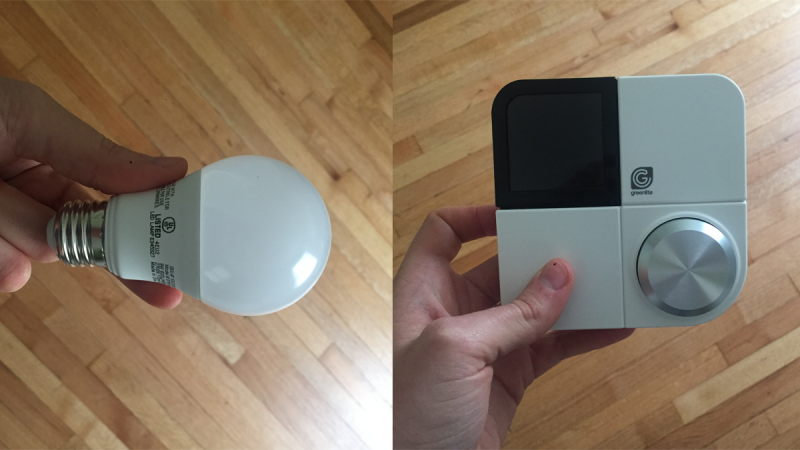
I bought discounted LED bulbs and received a free smart thermostat in the mail from Ameren after signing up online.
4. What is my supply rate?
When I was trying to calculate potential savings with community solar, I had to think about my supply rate. I have Ameren as my supplier. Most community solar offers that guarantee savings base those savings percentages on the default utility rate, so I knew I would be getting the full value of my subscription.
CUB recommends cancelling with an alternative electric supplier before signing up for community solar. We have heard reports that not all suppliers are fully crediting community solar customers for the value of their subscriptions. CUB has also heard that not all suppliers are even offering net metering, even though it is required by law. If you have rooftop panels and you switch suppliers after going solar, you will lose any built-up net metering credits, just like I lost my Mariano’s Rewards when I moved out of Chicago. (It’s ok – I have Schnucks Rewards now.)
5. How can I compare offer terms?
I’ve always been a comparison shopper – I am not a Coke or Pepsi person, but rather a Great Value Ginger Ale kind of gal. The size of a solar subscription is specific to the household, so it’s hard to know what terms are reasonable without comparing at least three offers. Companies participating in either solar program are required to send two official program documents to customers: the Informational Brochure, and the Standard Disclosure Form. The Informational Brochure explains the basics of the state program (here for Illinois Solar for All and here for Illinois Shines).
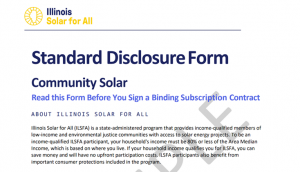
Example of an Illinois Solar for All Standard Disclosure Form
The Standard Disclosure Form breaks down the offer terms (here for Illinois Solar for All and here for Illinois Shines). It includes contact information for your provider, how to file a complaint with the program administrator, the length of the contract term, when you’ll start receiving bill credits, any fees you’ll be responsible for, and whether your provider is guaranteeing savings. I contacted three companies and received Standard Disclosure Forms for each offer. I dusted off my magnifying glass, poured myself a generous glass of boxed wine, and got ready for some fine print reading.
6. Does the offer guarantee savings?
Clean energy is affordable energy, but also where there’s a will, there’s a profit motive. I needed to be sure that I would see savings with my subscription. I checked the Standard Disclosure Forms and contracts to confirm there weren’t cost escalator provisions, which would raise the subscription rate over the contract term.
The three offers all guaranteed savings based on the default utility rate, but at different amounts:
| Company | Savings |
| Company A | 20% |
| Company B | 20% |
| Company C | 10% |
7. How long is the contract term – and does it automatically renew?
The typical contract term length we’ve seen so far for Illinois Shines is 15 years, and the program does allow contracts to auto-renew, so double check those terms.
While 15 years may sound like a long time, if and when you move, you can keep your community solar subscription as long as you stay in your utility service territory. And you can cancel before the term is up, though you may have to pay a fee depending on the company. Which led me to my next question…
8. Is there a cancellation fee?
Some providers will charge a fee if you cancel your subscription before the contract term is over. The Illinois Shines program allows any customer to cancel their subscription without paying a fee if they find a customer to take their place. It’s like the Hunger Games, but with utility bill credits in place of bloodthirsty children.
If I’m being real, I don’t know where I’m even going to be over the next 15 years, so I wanted to make sure that if I had to cancel, it would be easy and cheap.
These were the three early termination policies:
| Company | Exit fee? |
| Company A | None (but canceling required 90 days’ notice) |
| Company B | $200 (canceling required 60 days’ notice, and there were three conditions where this can be waived, including: death, moving out of utility service territory, and transferring the subscription to another customer) |
| Company C | None |
9. When will I start being billed by my community solar provider, and when will I see credits on my utility bill?
Most of the Illinois Shines projects are expected to be energized by the end of 2020. I like to picture 112 Dr. Frankensteins across the state simultaneously shouting, “It’s Alive,” while yanking a lever, and I should also never be put in charge of utility interconnection. I could be seeing bill credits as early as March 2021. That may sound like a long time away, but companies are starting to market their subscriptions now, because they can get more money from the state program if they have more “small subscribers” (like households) at the time their project comes online.
I checked the three Standard Disclosure Forms for what would happen if the project were delayed. All three would not bill me until I started receiving utility bill credits from Ameren.
10. Is there a credit check? Will I have to enroll in auto-pay? How will I be billed?
Okay, this is technically three questions. But don’t worry; we’re almost done. I didn’t personally mind a credit check, but that can be a huge barrier. I wanted to make sure that if I signed up for auto-pay, I’d still be able to easily access my billing history. Also, I wanted to make sure I was receiving a separate utility bill, so I could clearly see how my bill credits were being applied, and keep control over my utility account.
Here were the answers for the three offers I looked at:
| Company | Billing | Auto-Pay | Credit Check |
| Company A | 2 bills (solar bill with 20% discount and utility bill with credits) | Optional but opt-out only (could switch to paper bills any time) | None |
| Company B | 2 bills (solar bill with 20% discount and utility bill with credits) | Optional (but with a $40 credit for 3 consecutive auto-payments) | “Soft credit check” (won’t impact score) |
| Company C | 1 bill (the company would bill me with the 10% discount, and I would rely on them to pay my utility bill) | Required | None |
I didn’t love that I had to enter my household income and complete Company B’s “soft credit check” before I could receive a Standard Disclosure Form and “Customer Agreement” (they also asked for my Social Security Number, though that was an optional field.) But within 5 minutes of submitting my information to the online portal, I was “approved” (based on an automated assessment from Experian). If only all of life provided such instantaneous validation. I considered reactivating my Facebook account to chase this high.
11. How reputable is the company?
Having spent approximately six million hours on hold, I wanted to make sure I was signing up with a company that would treat me well as a customer. The Illinois Shines program maintains a public Consumer Complaint Database that I could check to see if other customers have had problems with a particular company. However, because the programs are so new, the only complaints listed were for rooftop solar.
To see complaints from community solar customers in other states, I checked the Better Business Bureau for all three companies.
By now, I had a pretty good idea of which offer I wanted to sign up for.
Company C’s offer promised the least savings, and would require me to turn over my utility account credentials, which made me uncomfortable. Company B’s offer was for a 20-year term, compared with Company A’s shorter 15-year term. And Company A’s contract would not automatically renew, which I liked. I didn’t want to be charged a cancellation fee, which made me lean toward Company A’s offer.
In the end, I made my decision by reviewing customer complaints. While I might have had a different experience with the company, I determined that overall, I would prefer a better customer service experience. I double-checked the Standard Disclosure Form, scanned the contract one last time, and signed.
I hope this was helpful for anyone considering signing up for community solar.
If you have any questions, I’d suggest reaching out to the program directly. For Illinois Solar for All, you can email [email protected] or call 1-888-970-4732. For Illinois Shines, you can email [email protected] or call 1-877-783-1820.
But you can also reach me at [email protected].
Good luck!
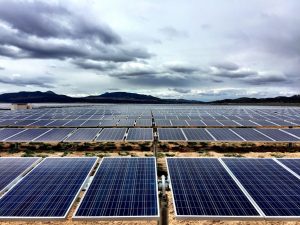
Next Steps:
- Find an Illinois Solar for All community solar project. (Vendor list here, income requirements here.)
- Find an Illinois Shines community solar project. (Vendor list here.)
- Look up the company on the Illinois Shines Consumer Complaint Database or the Better Business Bureau.
- Take advantage of electric efficiency programs through ComEd or Ameren Illinois.

